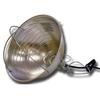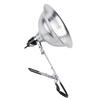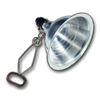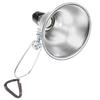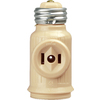36 gallons? Your water tank might be too big.
CFLs come in 15, 26, 42, 65, 85 and 105 watts.
The 26s and smaller are like big breasts on a nun, and not good for anything.
26s to 85s do not put out any noticable heat. The 105s put out some heat, but not as much as HID lights.
The 42's are about $9 each.
65 watts are abut $24 to $25 each, 85s are $30 each, 105s are $39 to $42 each, average is $40 each for 105s.
a CFL needs a reflector, like a hood. I like the $10 heavy duty clamp reflectors at Lowes, Home Depot or Walmart. They also offer a cheaper $8 reflector but it is smaller and flimsey.
With CFLs, you need the DUAL SPECTRUM, red and blue. That does not refer to the color of the bulb that you see. It refers to the kind of rays, UVA or UVB, or the color temp, called kevins.
CFLS come in 2700 kevins, 3000, 4100, 5100, and 6500.
2700k is for BLOOM OR FLOWERING , 6500k is the VEG Spectrum. The others are "MID" spectrums or in between.
In outdoors, the sun produces different rays in the spring (VEG Rays called Blue) and late summer for Bloom spectrum, the RED spectrum. (see more below)
CFLs are new on the scene, in 2006 the biggest made was 65 watts. When we talk about CFL watts, we are talking about the actually electricity used, NOT the equivalant. For example, a 15 watt CFL bulb puts out 60 watts.
CLFS PUT OUT LIGHT FROM THE SIDES, NOT THE ENDS OR TIPS.
YOU CAN GET SPIRAL CFLS (15, 26, 42, 65, 85) AND TUBE TYPE CFLS 105s.
this is from a magazine artice I wrote and a newsletter I wrote for Stealth Hydro:
How much light is needed for growing?
Depends on the size of plant you are trying to grow. I'll try to answer this "in general" instead of being specific to one size plant. Light seen and perceived with the human eye is measured in Lumens. There is an ideal amount of lumens for growing and a minimum amount of required lumens. The very minimum amount of light required for smaller sized plants grown is around 3000 lumens per square foot. Let me put emphasis on "minimum amount" of light. However, that's not 100% exactly accurate, since although you may have a 10,000 lumen light, the amount of light that reaches the plant varies with the distance between the light and plants, and the reflectivity of the grow area. The ideal amount is somewhere around 7000-10,000 lumens per square foot for average sized plants. As long as the plants do not show burn, as much light can be used as you want to use. (Note, the sun produces about 10,000 lumens per square foot, on a sunny mid summer day).
Determining lumens for your grow area:
First determine the square footage of your area (example in a 4 foot by 4 foot area, there is 16 square feet, 2 by 2 feet is 4 Sq ft. ) If you have a 1000 Watt High Pressure Sodium Light Bulb, that produces approximately 107,000 lumens. Divide this by 16 (your square footage) 107,000 divided by 16 = 6687 lumens per square foot. So just divide the total amount of Lumens, by the total amount of square feet, and that's your lumens per square foot.
How far away from my plants do the lights go?
The lights in your grow room should be as close as possible to the plants without burning them. There is no such thing as too much light, unless there is overly sufficient heat to dry out and burn the leaves. A good rule is to put your hand under the light, if its too hot for your hand, chances are that the plants will be too hot too, so move the light up until your hand feels more comfortable. For seedlings or sprouts, I keep them a little further away from the light, because they are very susceptible to burning and drying out, at these young stages.
How do I decide which lights to use?
Efficiency is very important when choosing a type of light. The wattage is not the most important thing, different types of light produce different amounts of lumens per watt. For example, a 300 watt incandescent will produce about 5100 lumens. (not that you can grow with incandescent bulbs) While a 300 watt Metal Halide (just an example, they do not come in 300 watts), will produce 27,000 lumens. Obviously far more efficient for growing, while still using the same amount of electricity.
Approximate light production:
Incandescents: 17 lumens/watt
Mercury vapor: 45-50 lumens/watt
Fluorescents: 60-70 lumens/watt
Metal halide: 90 lumens/watt
High pressure sodium: 107 lumens/watt
Incandescent lights: Incandescent bulbs are the most popular type of lights in the world. They may come advertised as incandescent, tungsten, quartz, halogen, or simply standard. The important thing about incandescent bulbs when it come to growing is simply this: they suck. Using incandescent bulbs to grow plants is like trying to flag down the Space Challenger with a burnt out match! You can do it, but it won't work. There are some incandescents which are sold as "grow lights." They usually have a blue coating and usually come in 60W and 120W sizes. While they may seem like a good choice to new growers, they are next to useless; they produce some light at a usable spectrum, but only have about a 5% efficiency and generate more heat than usable light. Most of us have these in our homes right now. Don't use them for growing, instead opt for a Compact Fluorescent, CFL, as a cheaper but more efficient alternative.
Fluorescent lights: Fluorescents are far more useful than incandescents. They are efficient enough, and much less expensive than HID (High Intensity Discharge) lights. Compact fluorescent tubes, (commonly called CFLs) are popular with growers because of their good output to size ratio. Compared to standard 4 foot tubes, CFLs are smaller, more easily moved, and more can fit into a given small area. CFLs are good for small grows on a tight budget, and for novice growers, since they do not require any special sort of wiring or understanding of the necessary bulbs for a given fixture, and the small wattage ones (23, 42 and 65) are very widely available. Fluorescent lights come in many different Kelvin (spectrum or color) ratings; often the spectrums are labeled on packaging as being 'cool white' or 'warm white.' Cool white is more blue, and is good for the vegetative stages of growth. The bulbs are ultra white. Warm white light is more reddish in spectrum, and is best for the flowering stage. The bulbs are almost cream colored.
Color rating - Measured in Kelvin (K). The higher the number, the more bluish the light. 4000K-7000K is mostly on the blue side of the spectrum for Vegging or GROWING, while 3000K and under goes from a white spectrum, to a redder spectrum and is best for BLOOMING or FLOWERING.
High Intensity Discharge (HID) Lighting Systems:
Mercury Vapor (MV)
Mercury vapor lights are not the most efficient light for growing. They are very bright, and relatively cheap. They do emit light at the wavelengths necessary to support your plants growth, but not nearly as good as a MH or HPS light. Much of the light emitted by MV lights is bluish-white. Street lighting is what most MV lighting is used for.
Metal Halide (MH)
Metal halide lighting systems are optimal for use in the vegetative phase of growing. They emit mostly blue light, which encourages vigorous growth of foliage. They are very efficient, but can get rather expensive to start with; fluorescents may seem more appealing because of their lower price, and they are not much different when compared on a lumen-to-lumen cost level. These lights can be used through-out the grow, but leave a lot to be desired in the BLOOM stage.
High Pressure Sodium (HPS)
High pressure sodium lights emit mostly orange, yellow, and red spectrum light, which is perfect for the flowering stage of the plants growth. They are (in my opinion) the most efficient type of light available for any application if you are not on a budget and can vent the grow area for heat. HPS lights can be used through-out the entire grow. They produce more dense and usually larger flowers or fruit than any other light. HPS lights are generally a little more expensive than MH systems of similar wattage. They are more commonly used by experienced commercial growers because of their ability to produce tighter denser flowers, higher lumen-output-per-watt, and will produce from start to finish.
Just like everything else, available grow lights are evolving. Remember how the sun produces 10,000 lumens per square foot in the mid-summer. Well, today there are CFLs that can actually duplicate those lumens. If you can not grow under the sun, then bring the sun inside. Yes, you can have 20,000 lumens covering the entire grow space with the new 105 watt per bulb CFLs. Three of these bulbs in the proper reflector actually yields 20,000 lumens.

